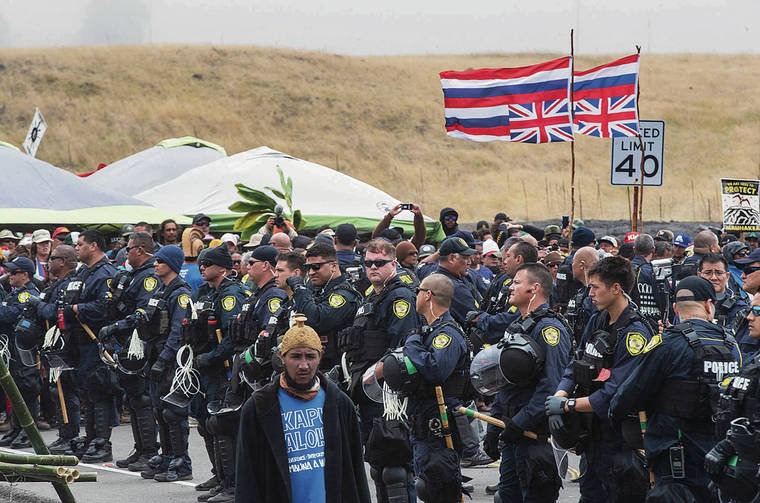HILO >> Hawaii County police have spent nearly $4.2 million on overtime, fringe benefits and other costs so far in connection with 11 weeks of protests against the Thirty Meter Telescope, members of the Hawaii County Council were told Tuesday. That sum works out to more than $50,000 per day.
Overall, the county’s police, Fire Department, Civil Defense and other agencies have spent more than $4.4 million coping with the protests. The total does not include overtime or other costs incurred by state agencies including the state
Department of Public Safety, the state Attorney General’s
office and the state Department of Land and Natural
Resources.
Thousands of opponents of the telescope project have gathered around the intersection of Daniel K. Inouye Highway and Mauna Kea Access Road at times, and the access road has been closed since July 15. On July 17 police arrested 39 people for blocking the road.
Hawaii island Police Chief Paul Ferreira has said the county scaled back considerably on the number of officers it keeps on hand near the protest site at the base of the Mauna Kea Access Road since the peak of the protest activity in mid-July.
Still, there is a considerable police presence on the mountain. Police announced on Sept. 26 that they had issued 3,501 citations to motorists on the Daniel K. Inouye Highway since Aug. 15 as part of a stepped up enforcement
effort in the areas around the protests.
The highway runs through the site of the protests, and police say the enforcement effort is intended to enhance motorists’ and pedestrians’ safety. Police deployed in the area also arrested 37 people, but say they don’t know how many of the people they ticketed or arrested have ties to the protests.
The activists say most of those who were cited were passing motorists or tourists with no connection to the protest camp.
The protesters say the TMT project is a desecration of a mountain that many Hawaiians consider sacred, and say they will not allow it to be built. Sponsors of the TMT project spent a decade navigating the state and county permitting processes and fending off legal challenges to the project, and TMT supporters say the project now has the legal right to proceed.
The protests have been non-violent, and some council members on Tuesday questioned the number and cost of the police deployed around the activists’ camp.
“Regardless of which side of the equation you are on, I don’t think too many people are real happy with the police presence up there,” said Council Chairman Aaron Chung. “They’re kind of wondering, what’s the reason?” He added, “It’s even from people who are in favor of TMT. They say, ‘Well, why?’ ”
County Finance Director Deanna Sako told members of the council’s Finance Committee Tuesday that the state has reimbursed the county for $150,354 in Fire Department expenses related to the protests, but the attorney general’s office so far has been unwilling to reimburse the county for police costs until the state and county sign a memorandum of agreement.
Sako said she hopes that agreement will be finalized by the end of this week. Gov. David Ige has assured members of the council that the state will reimburse the county for its overtime costs as well as other costs associated with the anti-TMT demonstrations such as food, water, equipment and portable toilets for use in the isolated protest area.
However, Sako told council members she does not expect the county will ever be reimbursed for more than $92,000 in protest-
related expenses charged to other departments.
That includes more than $59,100 that has been paid out of the mayor’s office budget to hire crossing guards who work on the Daniel K. Inouye Highway at the protest site. Those crossing guards assist streams of activists to cross safely back and forth across the highway each day from the puuhonua at Puu Huluhulu to the blockade and tents on the Mauna Kea Access Road.
Some council members including Puna Councilman Matt Kaneali‘i-Kleinfelder were clearly concerned with the amount of county spending on the protests as well as the delays in the reimbursement from the state.
“We’re $4.4 million in, and … we have more officers on Mauna Kea than I do in Puna, and I’m getting reports from around the island that our level of service has not been up to par, which is what was promised, that we would not lose (service) when we started this,” he said. “So, I have some concern that we have overstepped financially, without an agreement, and that we are needing to take a step back to protect ourselves here.”
The totals for Hawaii County police overtime do not include the regular-time cost of Hawaii County police deployed on the mountain because only overtime costs will be reimbursed by the state.
The Honolulu Police Department reported spending more than $162,351 on overtime, airfare and shipment of vehicles to help deal with the Mauna Kea protests, and Maui County reported spending $68,000 to send 27 Maui police officers to help.

